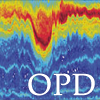|
Anda Vladoiu Senior Oceanographer avladoiu@apl.uw.edu Phone 206-685-9080 |
Education
M.S. Oceanography, University of Southampton (Southampton, UK), 2015
Ph.D. Physical Oceanography, University of Sorbonne (Paris, France), 2018
|
Publications |
2000-present and while at APL-UW |
A divergence and vorticity view of nonlinear oceanic lee wave obtained by a two-vessel survey Chuang, T.-L., J.-L. Chen, M.-H. Chang, R.-C. Lien, Y.-H. Cheng, Y.J. Yang, S. Jan, and A. Vladoiu, "A divergence and vorticity view of nonlinear oceanic lee wave obtained by a two-vessel survey," J. Geophys. Res., 130, doi:10.1029/2024JC021422, 2025. |
More Info |
1 Mar 2025 |
|||||||
|
Key Points |
|||||||||
Turbulence generation via nonlinear lee wave trailing edge instabilities in Kuroshio–seamount interactions Yeh, Y.Y., and 7 others including R.-C. Lien and A. Vladoiu, "Turbulence generation via nonlinear lee wave trailing edge instabilities in Kuroshio–seamount interactions," J. Geophys. Res., 129, doi:10.1029/2024JC020971, 2024. |
More Info |
1 Sep 2024 |
|||||||
|
Physical processes behind flow-topography interactions and turbulent transitions are essential for parameterization in numerical models. We examine how the Kuroshio cascades energy into turbulence upon passing over a seamount, employing a combination of shipboard measurements, tow-yo microstructure profiling, and high-resolution mooring. The seamount, spanning 5 km horizontally with two summits, interacts with the Kuroshio, whose flow speed ranges from 1 to 2 m s-1, modulated by tides. The forward energy cascade process is commenced by forming a train of 2–3 nonlinear lee waves behind the summit with a wavelength of 0.5–1 km and an amplitude of 50–100 m. A train of Kelvin–Helmholtz (KH) billows develops immediately below the lee waves and extends downstream, leading to enhanced turbulence. The turbulent kinetic energy dissipation rate is O (10-7–10-4) W kg-1, varying in phase with the upstream flow speed modulated by tides. KH billows occur primarily at the lee wave's trailing edge, where the combined strong downstream shear and low-stratification recirculation trigger the shear instability, Ri < 1/4. The recirculation also creates an overturn susceptible to gravitational instability. This scenario resembles the rotor, commonly found in atmospheric mountain waves but rarely observed in the ocean. A linear stability analysis further suggests that critical levels, where the KH instability extracts energy from the mean flow, are located predominantly at the strong shear layer of the lee wave's upwelling portion, coinciding with the upper boundary of the rotor. These novel observations may provide insights into flow-topography interactions and improve physics-based turbulence parameterization. |
|||||||||
Energy partition between submesoscale internal waves and quasi-geostrophic vortical motion in the pycnocline Vladoiu, A., R.-C. Lien, and E. Kunze, "Energy partition between submesoscale internal waves and quasi-geostrophic vortical motion in the pycnocline," J. Phys. Oceanogr., 54, 1285-1307, doi:10.1175/JPO-D-23-0090.1, 2024. |
More Info |
19 Feb 2024 |
|||||||
|
Shipboard ADCP velocity and towed CTD chain density measurements from the eastern North Pacific pycnocline are used to segregate energy between linear internal waves (IW) and linear vortical motion (quasi-geostrophy, QG) in 2-D wavenumber space spanning submesoscale horizontal wavelengths λx ∼ 1 – 50 km and finescale vertical wavelengths λz ∼ 7 – 100 m. Helmholtz decomposition and a new Burger-number Bu decomposition yield similar results despite different methodologies. Partition between IW and QG total energies depends on ðµð‘¢. For Bu < 0.01, available potential energy EP exceeds horizontal kinetic energy EK and is contributed mostly by QG. In contrast, energy is nearly equipartitioned between QG and IW for Bu » 1. For Bu < 2, EK is contributed mainly by IW, and EP by QG, while, for Bu > 2, contributions are reversed. Vertical shear variance is contributed primarily by near-inertial IW at small λz, implying negligible QG contribution to vertical shear instability. Conversely, both QG and IW at the smallest λx ∼ 1 km contribute large horizontal shear variance, such that both may lead to horizontal shear instability. Both QG and IW contribute to vortex-stretching at small vertical scales. For QG, the relative vorticity contribution to linear potential vorticity anomaly increases with decreasing horizontal and increasing vertical scales. |
|||||||||






